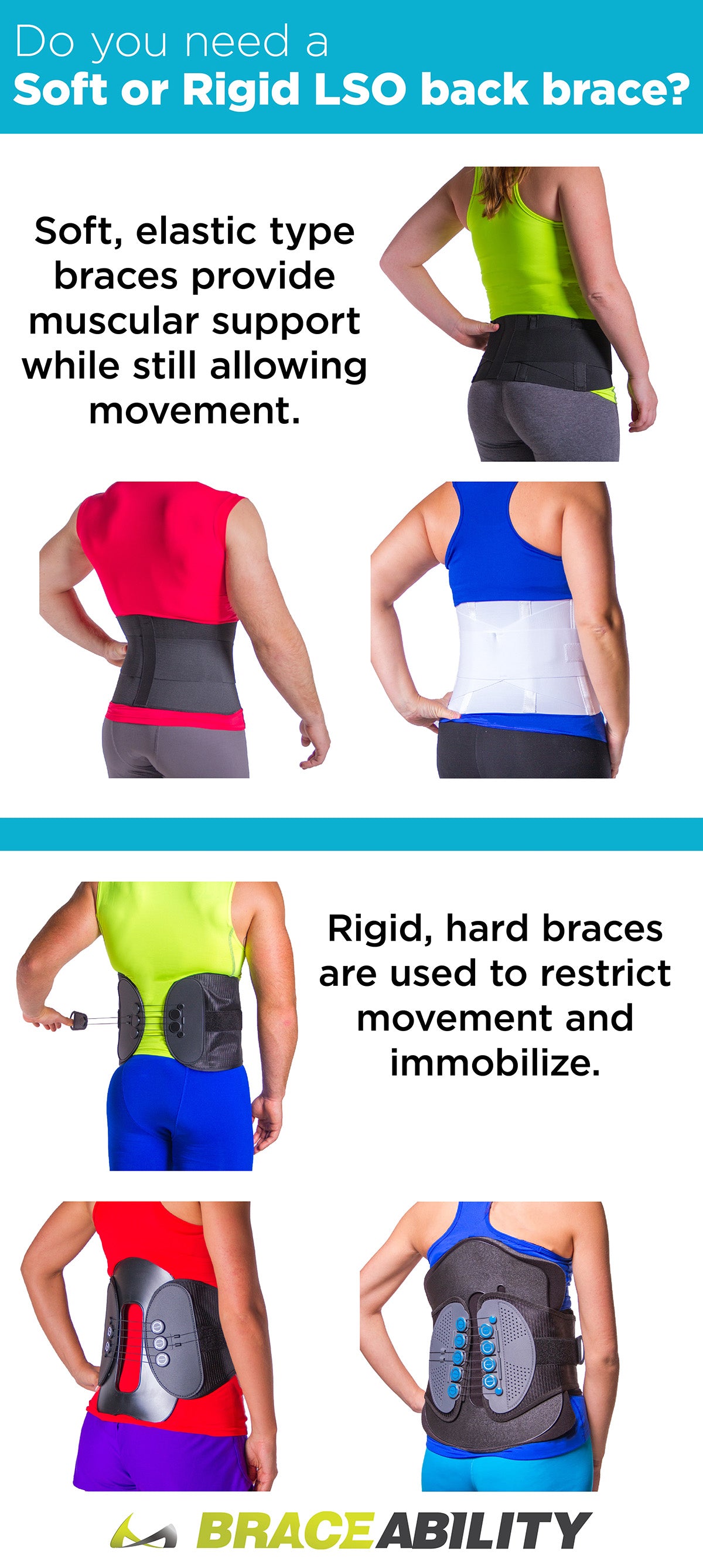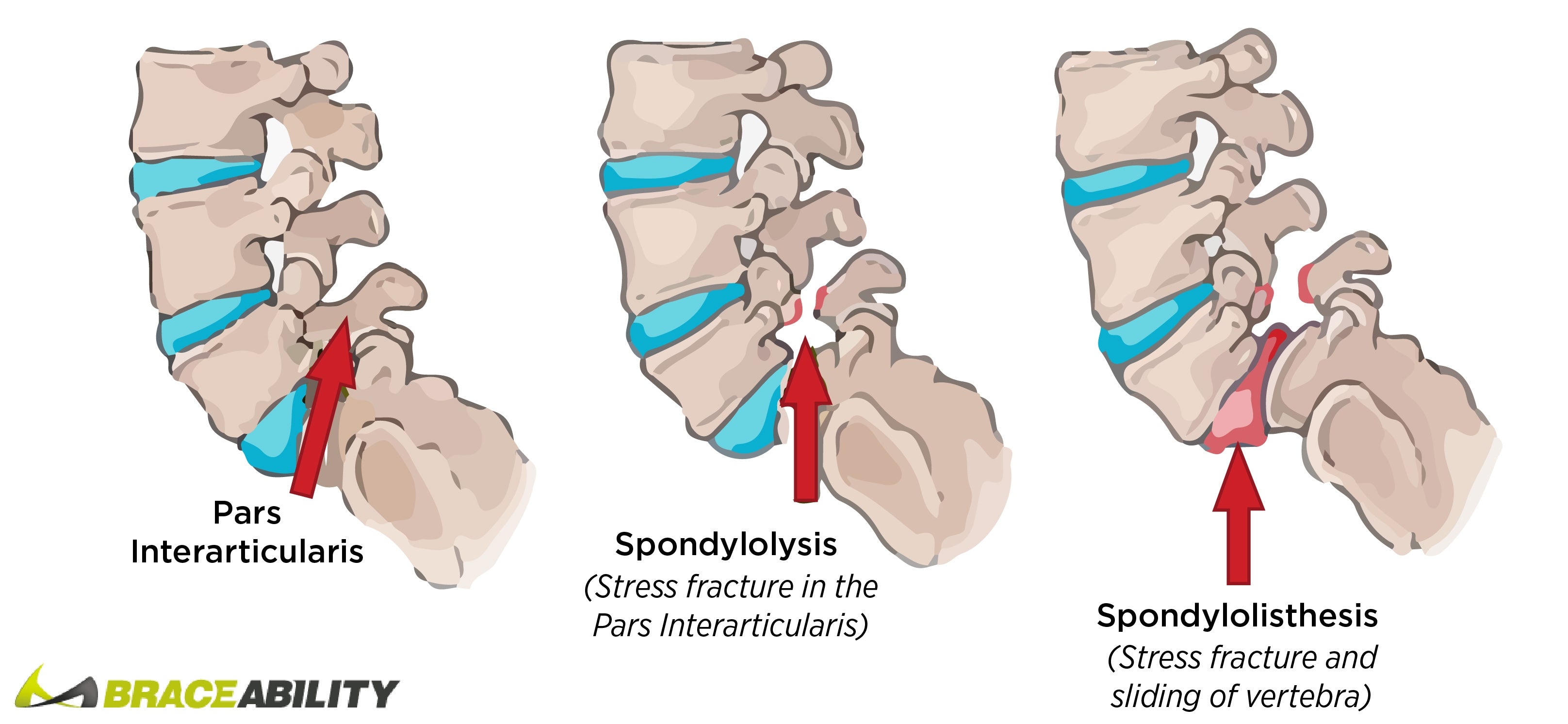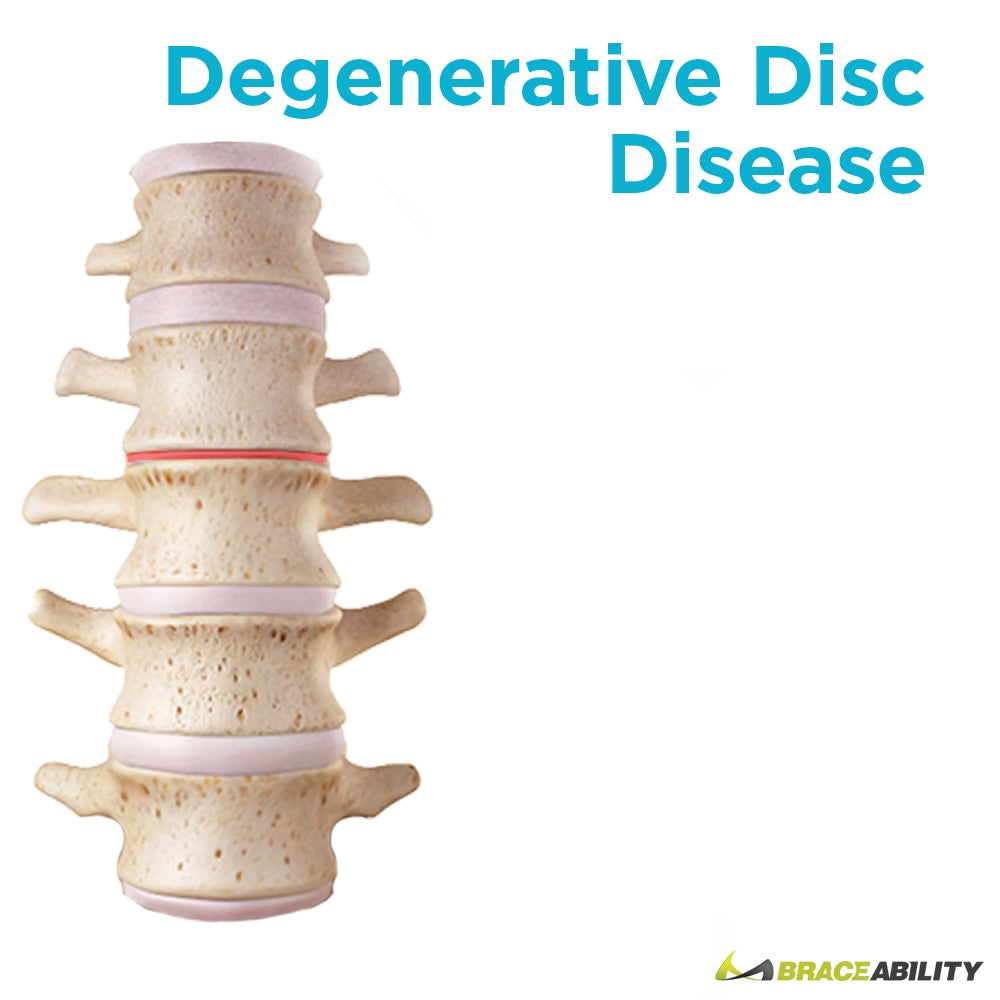What is an LSO Brace?
As you probably guessed, back braces are external devices that support the muscular and bony structures of your spine. An LSO, lumbar sacral orthosis, is a brace that specifically focuses on immobilizing and supporting your lumbar spine. The image to the right shows where the lumbar spine is located on your body.
Lumbosacral back pain due to injuries and disorders is the culprit for low-back pain that affects countless people worldwide. Fortunately, BraceAbility offers a wide range of lumbosacral orthosis (LSO) products from corset braces to belts to rigid back supports, including several L-Code approved back braces that can be reimbursed by your insurer.
BraceAbility also offers a variety of sizes for both men and women, with braces ranging from regular to plus size, designed to treat various sources of lumbosacral pain.
Why Do I Need an LSO Back Brace for Lumbosacral Pain?
Lumbosacral back braces are an essential component to the successful treatment of your spinal disorder. In the past, many spine patients were required to wear heavy plaster casts.
Fortunately, patients that must wear braces today benefit from lighter weight plastic braces that have been designed with the patient's comfort in mind.
Although braces may require you to restrict some activities or form different habits, the support provided by LSO back braces will speed your healing and may prevent further injury.
When to Use a Soft Corset LSO vs. Rigid LSO
Back braces, sometimes referred to as abdominal supports, are categorized as rigid or soft. Rigid braces are used to restrict movement and immobilize, while soft, elastic type braces provide muscular support while still allowing movement
Soft Lumbosacral Corset
Additional support provided by soft lumbosacral corsets may be helpful if you have or are recovering from the following:
-
Lower back pain
-
Mild instability of your lumbar spine
-
A recent lumbar spinal surgery

The soft lumbar corset is used primarily for muscular support in your low back. The purpose of this brace is not for complete immobilization, but rather to serve as a gentle reminder to avoid excessive low back motion and may help to encourage proper body mechanics, including good posture.
Ideally, this type of back brace should be worn when you are involved in activities that place your back at risk.
Rigid Back Brace
Additional support provided by a rigid or semi-rigid back brace may be helpful if you have or are recovering from the following:
-
A very complex spinal surgery, especially fusion procedures
-
Spinal instability post op
-
Spondylolysis
-
Spondylolisthesis
-
Degenerative disc disease
-
SI joint pain
Rigid braces are generally constructed out of form-fitting plastic molds that will restrict motion up to 50%, providing more immobilization and support than soft braces. The additional immobilization allows your back to safely heal with a minimal risk of further injury.
Lumbar Sacral Orthosis for Spondylolysis and Spondylolisthesis Treatment
Spondylolysis, a stress fracture, occurs when there is a separation of the pars interarticularis, which is the small bony arch towards the back of your spine. This can cause your bones to weaken to such an extent that one shifts out of place. When this happens, the progression from spondylolysis to spondylolisthesis occurs.

Most cases of lumbosacral spondylolysis and spondylolisthesis stem from minor overuse traumas, specifically when your lumbar spine is hyperextended repeatedly. Spondylolisthesis can be caused by sports that involve repetitive hyperextensions of the lumbar spine, such as football, baseball, rowing, tennis, baseball, wrestling, volleyball or weightlifting.
Some of the most common symptoms of spondylolysis and spondylolisthesis include; lower back pain during exercise and numbness/tingling or weakness in your legs caused by nerve compression (sciatica) that can be brought on by spondylolysis or spondylolisthesis.
Wearing an LSO brace is one way of treating spondylolysis and spondylolisthesis. Not only does a lumbosacral orthosis brace help relieve pain associated with spondylolisthesis, but it also helps prevent further slippage of your vertebrae. BraceAbility offers a wide range of LSO support products specifically designed for spondylolysis and spondylolisthesis treatment.
This stabilizing corset, in particular, is well suited for the treatment of spondylolisthesis, among other conditions. This comfortable lumbosacral orthotic provides support for your lumbosacral region and features rigid, heat-moldable panels in the front and rear that help stabilize your lumbar spine.
LSO Back Support for Treating Disc Disorders
A common cause of back pain is degenerative disc disease, which refers to the changes that happen in your spinal discs as you age. These changes in your discs can cause low-back pain, as well as the development of conditions including osteoarthritis, spinal stenosis, or herniated discs. These conditions in and of themselves can cause other issues, such as sciatic nerve pain.
 Thankfully, a lumbar sacral orthosis can help treat sacral lumbar pain stemming from degenerative disc conditions. Our comprehensive full back stabilizer braces for thoracic and lumbosacral support features a removable panel and frame, a chair-back design and a mechanical pulley system that allows easily adjustable compression. Adding to the customizable aspect of this brace, the frame is heat-moldable. This LSO back brace stabilizes the spine, without sacrificing mobility. This brace is also ideal for recovery from lumbosacral surgery.
Thankfully, a lumbar sacral orthosis can help treat sacral lumbar pain stemming from degenerative disc conditions. Our comprehensive full back stabilizer braces for thoracic and lumbosacral support features a removable panel and frame, a chair-back design and a mechanical pulley system that allows easily adjustable compression. Adding to the customizable aspect of this brace, the frame is heat-moldable. This LSO back brace stabilizes the spine, without sacrificing mobility. This brace is also ideal for recovery from lumbosacral surgery.
LSO back braces provide immediate relief from pain caused by lumbosacral disc disorders by taking pressure off your lumbosacral disc and shifting the load to your abdominal region. The anterior (front) and posterior (back) panels of this back brace help to stabilize your spine and abdominal region so your bones and muscles can heal properly. This lumbosacral brace is also perfect for chronic and acute back pain, strains/sprains to your lumbar muscles and as a postural support. It is also a popular post-surgery brace.
SI Joint Pain Treatment
Another source of pain in the lumbosacral region of your body stems from dysfunction in the sacroiliac (SI) joints, which attach your pelvic bones to your spine. If your joint allows too little or too much motion, SI joint pain along with radiating pain in your hips, groin, thigh can occur. This is especially common in pregnant women as hormonal changes can increase the looseness of their joints.
SI joint dysfunction treatment often involves wearing a sacroiliac belt to stabilize and support your joints. Consider, for instance, this sacroiliac joint belt / SI brace, which supports, reduces pain, and stabilizes sacroiliac joints through circumferential compression of your sacral region.
Stretching and stability exercises can also help to stabilize your SI joints. In some instances, a cortisone injection or treatment of some underlying causal factor may be needed for SI joint pain relief
Lumbosacral Plexus Injury
The lumbar plexus refers to a division of nerves in the lumbar and sacral region of your body that provides innervations to your lower limbs. These nerve roots are protected by your pelvis. Therefore, lumbosacral plexus injury is rare and typically stems from major trauma that fractures your pelvic bones.
Injury to your lumbosacral plexus can result in diminished sensation and movement of your hip, leg, ankle, and toes or complete paralysis of the gluteus muscles. The movement may be accompanied by a burning, tingling or cramping sensation.
Treatment for lumbosacral plexus damage typically involves reconnecting your nerves, in some cases via nerve grafts, followed by rehabilitation to manage pain and maintain motion of your tendons and muscles. During this rehabilitation process, a doctor might recommend wearing a lumbosacral support.
Soft Tissue Lumbar Sacral Injury
Another type of lumbosacral injury is sprain or strain to your back muscles, tendons, or other soft tissues, such as your lumbar dorsal fascia membrane covering the deep muscles of your trunk.
The combination of weak abdominal muscles and a tight lumbar dorsal fascia, also known as thoracolumbar fascia, can result in lumbar fascia pain.
Strength exercises and stretches for your core along with massage can be helpful for lumbar fascia strain. There are also braces specifically designed with this condition in mind, such as this back belt. This brace features suspenders that can be used or removed, as needed for more or less back support.
Soft tissue injuries can often be treated with rest and ice. A low-back brace can be helpful to both these ends.
Not sure what lumbosacral orthotic is best for you? No problem. Our customer service representatives are always here to help. To speak with one, please call us at (866) 712-7808.
















